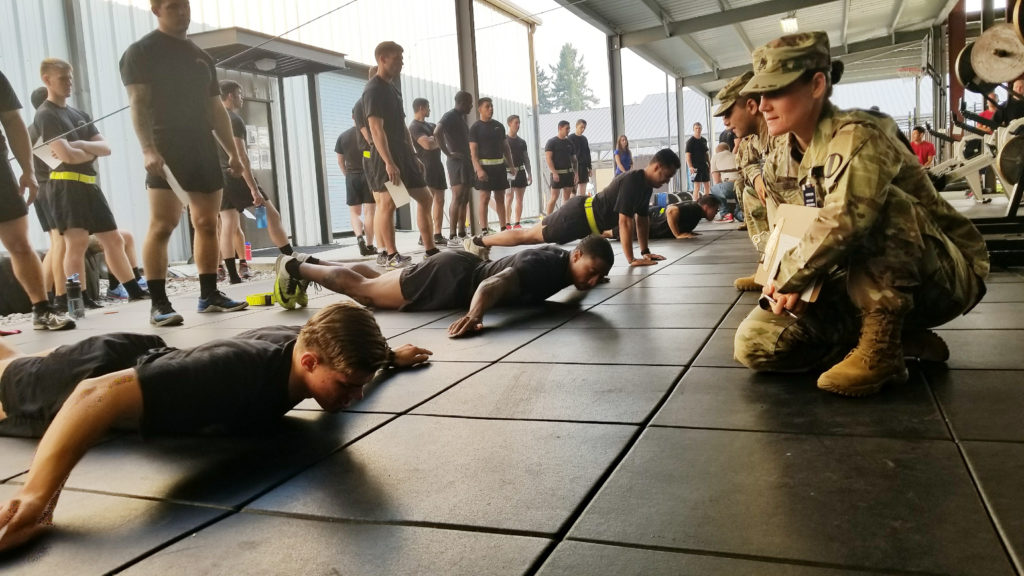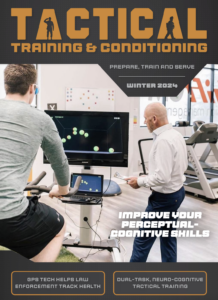Winter 2023
Train like a tactical athlete

Within the past few years, a new buzzword has been utilized more and more frequently within the strength and conditioning field concerning the first responder community. That is the term tactical athlete.
So, what is meant by the terminology of being a tactical athlete?
The tactical athlete, depending on their job description, may be training based on what they have historically known or what they have been taught. If they are not basing their physical fitness regimen upon a progressive detailed strength and conditioning program then they may be falling shy of achieving optimal athletic performance and their career. Strength and conditioning is paramount to elicit premium physiological adaptations that will result in becoming a better tactical athlete. A tactical athlete has to be able to have all the physiological adaptations that a sports athlete has but they have to have it day in and day out, every day of their profession. They need to exhibit feats of strength, power, aerobic and anaerobic capacity, flexibility, stability and mobility through everyday functional movements to aid in better human performance.
The tactical athlete needs to train their body in all three anatomical planes of motion confidently and precisely. Furthermore, they must exhibit qualities of resiliency and recovery which are both key components in safely maximizing their career and more importantly, longevity in life. Through this writer’s 27-plus years of dedicated Federal Service as a Drug Enforcement Administration Special Agent and a New Jersey State Trooper, there are clearly cognizant concerns and issues that face tactical athletes in their respective professions. A tactical athlete or operator has to pass a bi-annual or yearly physical fitness assessment that measures their physical proficiency.
First and foremost, the tactical athlete, unlike a sports athlete, has no off-season. This means they do not have months and months to prepare to be at optimal performance for a set period based on a season’s game schedule. They have to be at peak performance every day during the year and have to be able to make critical and life-changing decisions for themselves, coworkers, and respective third parties. They are typically afforded a working schedule for a few months at a time. Their schedule can be either an eight, 10 or 12-hour day and may or may not include shift work — which depending on the agency or department may rotate every three to four weeks. This abnormal sleep schedule disrupts the normal body chemistry of hormone production and plays a significant factor in the ability of the tactical athlete, to perform optimally when called upon. Therefore, it is incumbent upon the tactical athlete to constantly adapt their changing schedule based upon the aforementioned variables.

Other variables include not eating or making the best food choices. For example, an officer may have well intentions to have a healthy meal a few hours into their shift but if a call for service comes up, then that takes precedence and the officer will miss the meal and then when free, rushes to consume something quick to satisfy their hunger but was not their original intended healthy choice.
It can also be the officer working undercover in a surveillance role or special agent that begins their day with the same intentions that believe they may have an eight-hour day of work to only find that their case has required them to be there for the next 24 hours. Or worse yet, they may be required to stay for a few days which subsequently means living out of their car. This same example holds true for the firefighter battling a call for duty that extends to these same prolonged hours. Or the military soldier that has their mission or current deployment extended beyond the original anticipated time and call of duty.
So how does an individual train like a tactical athlete?
Now that the job description and role of a tactical athlete are clearly defined, how does an individual train like one? Some of the variables that need adherence when implementing a sound program design for a tactical athlete should be centered upon the following:
- Conducting training based on a tactical athlete’s job description entails devising a program design for what they do through utilizing the three anatomical planes of human movement. All tactical athletes need to be able to efficiently train their bodies in the sagittal, frontal, and transverse planes of motion. Working this way makes the tactical operator better equipped to successfully conquer any physically demanding task they encounter. An operator who only conducts endurance-based events in the sagittal plane may encounter difficulty when called upon in an encounter that requires them to move smoothly, efficiently, and powerfully in the frontal and transverse planes. Not only does this accomplish these objectives but also assists the operator in assisting them in preventing musculoskeletal (MSK) injuries.
The three anatomical planes of human movement are the following:
- (A) Sagittal — Sagittal (longitudinal) plane: separates the left and right sides of the body
- (B) Frontal — Coronal (frontal) plane: separates the front (anterior) and back (posterior) of the body
- (C) Transverse — Transverse (axial) plane: separates the upper (superior) and lower (inferior) halves of the body.
- Conducting training to elicit optimal performance through energy systems is necessary to meet the demands of the job. The cop that is assigned patrol may find him/herself going from a sedentary position behind the wheel to only be engaged in a foot chase or “fight or flight” encounter which requires adaptations of both anaerobic and aerobic energy systems. An individual that has the assignment of a battering ram door breacher on a tactical entry team needs to be strong, powerful, and explosive and should be trained to make the physiological adaptations that their body requires through the phosphagen energy system.
- Lastly, the tactical athlete necessitates the need for proper implementation of available exercise equipment to develop themselves for optimal performance. Having access to gyms and weight training facilities is a benefit but what happens when a soldier is deployed and does not have access to a gym or their gym in a box? Additionally, during the COVID pandemic, many operators were unprepared to keep their daily fitness gymnasium regimens because of operational closures. If an operator is given the tools to think outside the box, with non-traditional means such as heavy bags, sandbags, etc., then they can still keep themselves in a mission-ready status.
The following is a brief list of how a tactical athlete should center their training which takes into account all three anatomical planes of movement. This is not an all-inclusive training list but rather a representative sample of the desired movement patterns in order to elicit optimal physical performance.
» ALSO SEE: NH Police Chiefs Ask to Drop Required Fitness Test
- Resistance Training Exercise Techniques — bench press, deadlift, squat, Romanian deadlift, front squat, goblet squat, farmer’s walk, push press, landmine presses and twists, bicep curls, tricep extensions, and Olympic lifts (hang clean, power clean, power snatch).
- Included are exercises that emphasize placing stressors and an external load on the anterior core (front & goblet squat). They also have a direct translation to certain movement patterns that are tested in the United States Army Combat Fitness Test, but can be considered as a more athletic movement to the back squat and can positively affect optimal physical performance.
- Bodyweight Exercises — pull-ups (wide, close, and reverse grips), straight arm dead bar hangs, push-ups, planks, TRX Bands (suspension squats, IYT, face pulls, med ball squat to throw, med ball slams, running, rucking, sprinting, swimming.
- Unconventional methods — sandbags, heavy bags, wheelbarrow carries, to name a few.
- Flexibility & Mobility Exercise Techniques & Programming — Mobility is affected by one’s ability to move freely through coordination and without restriction. Flexibility does not indicate the ability to move but rather the ability for one to develop a range of motion for one’s muscles, ligaments, and tendons. Stability is the ability to maintain control of joint movement around its axis.
- Types of Stretching — static, ballistic, and dynamic. Dynamic stretching is considered one of the premium forms of stretching. Furthermore, it aids in optimal sports performance by increasing the range of motion and the force, power, and sprint and jumping output.
Daniel J. Borowick, MS, CSCS, is a former DEA Special Agent and Physical Task Test Administrator. He has more than 27 years of tactical experience in state and federal law enforcement. Currently, he is a strength and conditioning specialist as a private contractor serving the US Army’s 1st Armored Divisions H2F Program. Any inquiries concerning this article and a program designed to achieve optimal physical performance and human movement to be a better tactical athlete can be directed to Borowick at Dmexfit@gmail.com.



